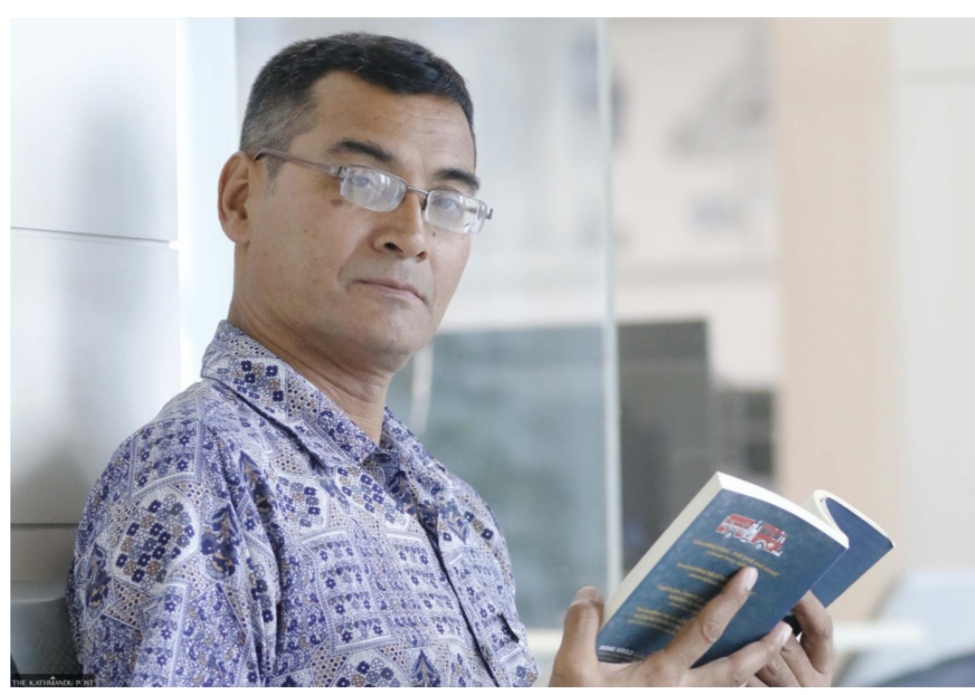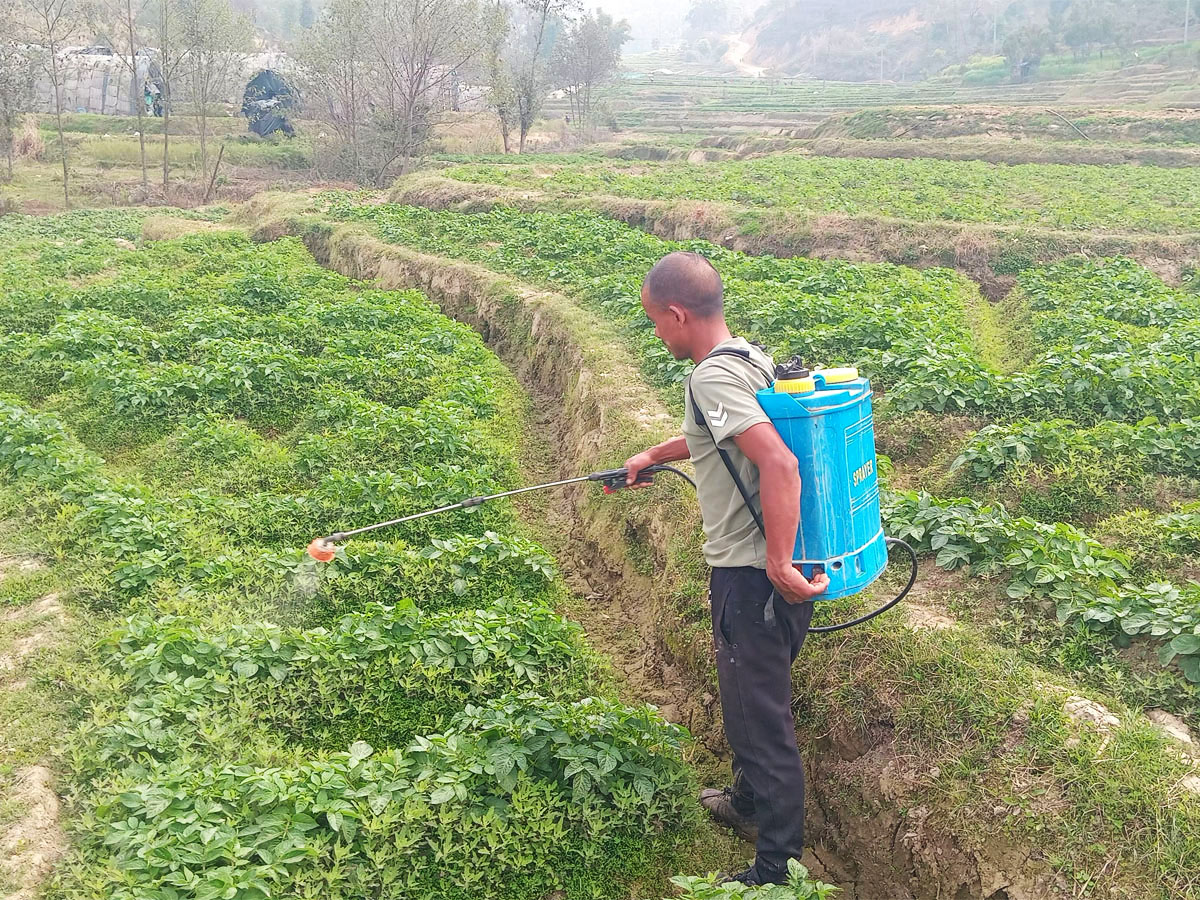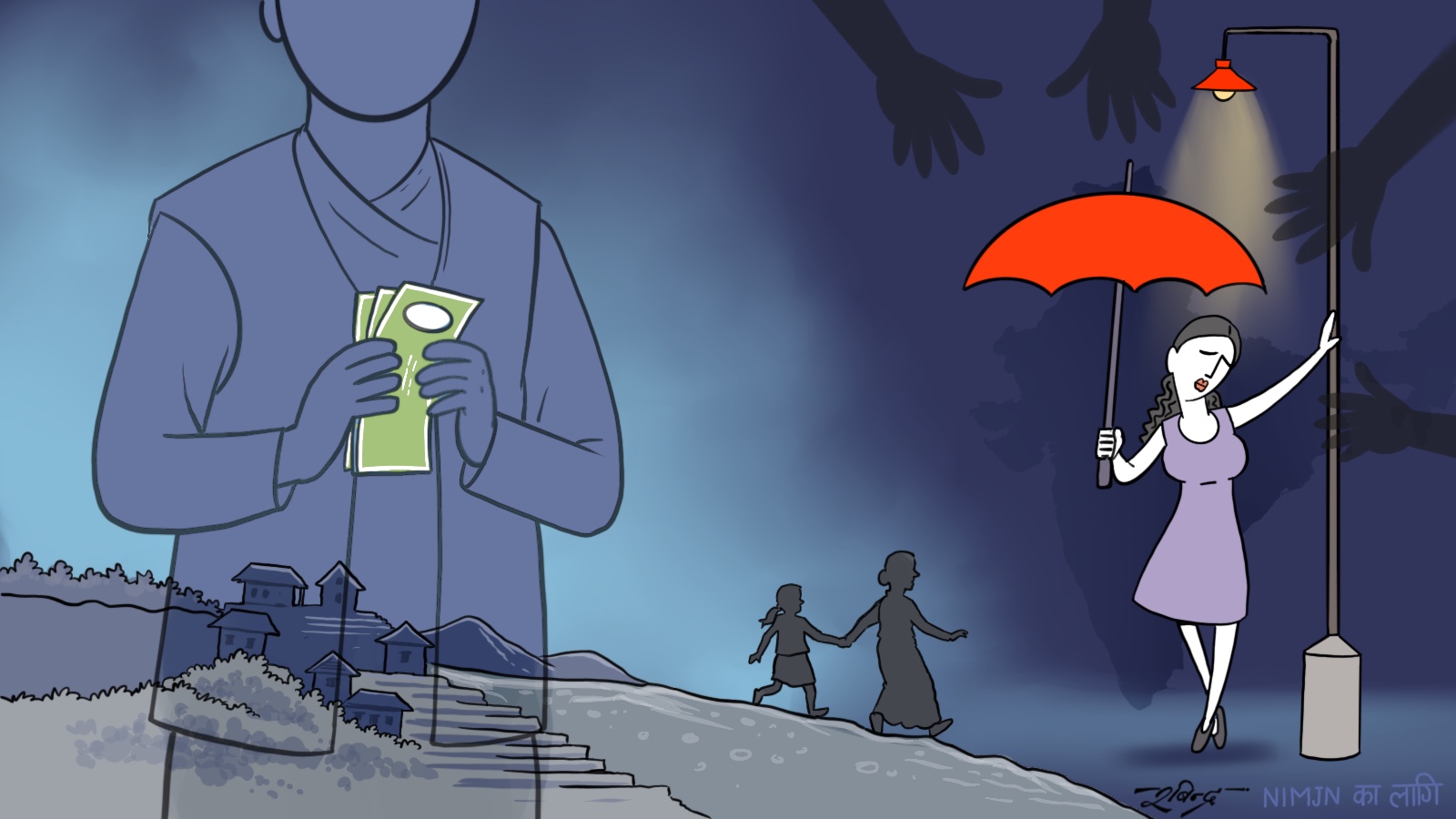Read the story in Nepali: बालबालिकाको तस्करी रोक्न जिम्मेवार निकाय उदासीन, बालबालिका संरक्षणमा छैन चासो
Read the first part of this series: Passage to India: How Nepali Children Are Smuggled to Monasteries Across the Border to the South
Read the second part here: Child Trafficking in Indian Monasteries: Violation of Child Rights
Pema Singtang, then ward member of Lalitpur's Bagmati Rural Municipality-7, was arrested along with seven others on November 30, 2021 in Thankot, Kathmandu.
 They were arrested by the Metropolitan Police Circle, Thankot, during a check while attempting to take 16 children to India. Singtang stated in his police testimony that he was taking the children to Drepung Loseling Monastery in Mundgod, Tibetan Colony, Karnataka, India, for education.
They were arrested by the Metropolitan Police Circle, Thankot, during a check while attempting to take 16 children to India. Singtang stated in his police testimony that he was taking the children to Drepung Loseling Monastery in Mundgod, Tibetan Colony, Karnataka, India, for education.
Although Pema showed a recommendation letter from the Nepal Buddhist Nyingma Palyul Sangh, he could not produce the necessary recommendation from the local Child Welfare Officer to take the children. Ward member Singtang himself was planning to take the children to India without documents through the Krishnanagar border crossing in Kapilvastu. In a conversation with us, Singtang said that the police stopped him because he was taking the children without documents and later returned them to their parents.
Among the 16 children being trafficked to India, seven children were 10 years old, two children were 9, and the others were 12 and 13 years old. These 16 children had been gathered from various villages in Godawari and Bagmati of Lalitpur, Kamalamai of Sindhuli, and Rasuwa to be taken to India.
Two weeks before Pema's arrest, on November 15, 2021, Santabir Lama from Devchuli Municipality, East Nawalparasi, was also arrested in a similar incident.
He was arrested when he reached the ward office of Sunkoshi Rural Municipality-4 in Sindhuli to obtain the necessary documents for taking children to India.
The then ward chairperson, Shankar Jargha Magar, stated that a letter from the monastery where they were said to be studying was also required. Lama immediately took out a letterhead of the monastery from his bag, wrote a letter, stamped it and submitted it. Suspecting his activities, the ward chairperson informed the Human Trafficking Investigation Bureau, after which the Area Police Office Khurkot, Sindhuli, arrested him.
Based on his statement after the arrest, the police rescued five children aged 10 to 14 from the Kadampa Monastery in Arubari. Santabir had brought two 10-year-old and one 13-year-old boys from Shankharapur Municipality in Kathmandu to this monastery, claiming he would take them to study at the Shar Gaden Monastery in Karnataka. The ward office of Ward No. 2 of Shankharapur Municipality had provided a recommendation letter to take them to India.
Sixteen children who were illegally taken from the Kispang Monastery in Nuwakot to India were returned to their parents on August 23, 2022 from Basti in Uttar Pradesh, India. They were being taken to the Shar Gaden Buddhist Cultural Association monastery in Karnataka for Lama studies.
A year prior to that, on September 14, 2021, police returned 14 children from Thasang Rural Municipality in Mustang to their homes from the eastern Nepal border. It was found that the ward chairperson of Ward No. 5 of Thasang Rural Municipality himself had provided the recommendation letter to take them to India.
The Council has records of incidents where children who could not bear the beatings and torture in gurukuls, ashrams, churches and madrasas, not just in monasteries operating in India and Nepal, have been rescued and brought back.
These incidents show that children from impoverished families in hilly districts are being taken to monasteries in India for education, and some local levels and people's representatives appear to be involved in this.
After the country adopted federalism, the district-level Women and Children's Offices and the District Child Welfare Committees were dissolved. In the past, these offices used to monitor children's homes and create mechanisms to prevent illegal trafficking, among other tasks. With the dissolution of these offices, the Local Government Operation Act, 2074, entrusted the responsibility of protecting children to the local levels (municipalities).
Section 61 of the Children's Act, 2075, stipulates that there will be a Child Welfare Officer at the local level to respect, protect and promote children's rights, as well as to carry out child protection work. Rule 82 of the Regulations, 2078, assigns the Child Welfare Officer the responsibility for all work related to children.
However, the people's representatives at the local level are unaware of this responsibility. Many local levels have not even appointed Child Welfare Officers. According to Namuna Bhusal, the Program Manager of the Child Rights Council, only 250 out of 753 local levels have appointed Child Welfare Officers.
Bhusal says, "Due to the failure to form child-related committees at the local level, it has become impossible to know where the children have gone and who is taking them for what purpose. The same problem is seen in the provinces." In her understanding, if the Provincial Child Rights Councils had been formed, the illegal trafficking of children would have decreased.
Laxmi Tamang, the Assistant Women Development Inspector of Marin Rural Municipality in Sindhuli, has also been assigned the responsibility of the Child Welfare Officer by the municipality. She says she has heard about the transportation of children from the village to monasteries but hasn't been able to do much to stop it. She states that no one has come to her for a recommendation to take children to India so far.
However, the Chairperson of the rural municipality, Bimarsha Moktan, says that his municipality issued 30 recommendations in the past year. Moktan explains that he was unaware of the rule that wards and municipalities cannot issue such recommendations, and because matters of religion and culture were involved, they had to issue recommendations based on verbal requests without proper documentation for taking the children.
Kapil Aryal, a co-professor at Kathmandu School of Law and a child rights activist, states that ward chairpersons and members who issue recommendations to place children in children's homes contrary to the law can be prosecuted for offenses against children.
He mentioned that the Children's Act has not clearly defined whether there is any difference between taking or sending children to monasteries for studies and placing them in children's homes or hostels. It is this loophole in the Children's Act that is being exploited for the trafficking of children under the pretext of sending them for studies in India.
Bhusal explains that although the Children's Act, 2075, assigns the responsibility to regularly monitor alternative care arrangements, rehabilitation centers, temporary protection services, observation rooms and residential institutions such as monasteries, gurukuls, gumbas, madrasas and churches where children are kept for educational purposes within the local level, and to submit reports of the same to the local authority committee and other relevant bodies, they have not been granted permission to enter these places. She says, "We have no information about the conditions inside."
The Council has records of incidents where children who could not bear the beatings and torture in gurukuls, ashrams, churches and madrasas, not just in monasteries operating in India and Nepal, have been rescued and brought back. She says that children who have returned after enduring torture do not want to go back to those institutions. She admits that the Council has not been able to study the conditions of monasteries in Nepal, not just those in India.
Bhusal states that because it is a matter and place connected to religious faith, one has to think a lot before intervening in such matters.
Traffickers are having it easy
The statements of the children rescued by the police reveal that Santabir used to enter villages in search of children and lure impoverished families.
According to information given to the police by a child from Sindhuli (name withheld), while he was staying at home after dropping out of Grade 7 at the village school, Santabir spoke with his parents and assured him and his elder brother that they would become great and learned masters by studying at a monastery in Karnataka. He stated in his testimony, "He told me to find other friends if I had any."
According to Bishal Bogati, the then investigation officer at the Human Trafficking Investigation Bureau, although Santabir said that food, accommodation and education would be free at the monastery, he collected ten thousand rupees per person from the children's parents as travel expenses when taking them to India.
In his statement to the police, Santabir claimed to have completed a Geshe, or PhD, in Lama studies from the Shar Gaden Monastery in Karnataka and stated that he was a Lama teacher and was taking the children to India to teach them.
The police had filed a case against Santabir in the Kathmandu District Court on charges of human trafficking and transportation. However, the court, based on the evidence and statements received, stated that it appeared Santabir was trying to take the children for education and that it could not be considered trafficking, acquitting Santabir on May 26, 2022.
Kapil Aryal, a co-professor at Kathmandu School of Law and a child rights activist, opines that transporting children by luring or promising them, regardless of the reason, without the approval of the local Child Welfare Committee, constitutes human trafficking.
Santabir has admitted that he was taking children to teach them when he came to Nepal on leave from the Shar Gaden Monastery in India. In a conversation with us, he said that even though the court acquitted him, he had to spend seven months in custody at that time.
"After spending seven months in jail, I have stopped transporting children to monasteries," he said. "In my free time now, I teach Tibetan language, do astrology, visit local monasteries, and perform rituals at the Jyowo Kadampa Monastery in Arubari."
Trafficking after the earthquake
Santabir of Devchuli Municipality, in his statement to the Human Trafficking Investigation Bureau, had stated that he had taken 70 to 80 people to study at monasteries in Karnataka over the past three years.
Immediately after the 2015 earthquake (2072 BS), police rescued children who had been gathered in Kathmandu from various places under the pretext of taking them to study in monasteries in India. At that time, 215 children who had been rescued from earthquake-affected Gorkha and brought to Kathmandu went missing.
According to the data of the then Central Child Welfare Committee, although 400 children were kept in the Lho Monastery in the former Lho Village Development Committee (VDC) of Gorkha, only 175 were present at the shelter established in Thankot, Kathmandu. Some children who were said to have been brought from the same monastery were rescued by the police from Dhading.
No one knows the condition of those missing children. Bhusal, the Program Manager of the Child Rights Council, says that the then Central Child Welfare Committee stopped the movement of children after many started disappearing during the earthquake. According to her, it was difficult to control the transportation of children to monasteries because those involved had access in many places.
When the committee tried to stop the trafficking, it faced pressure even from higher authorities. According to Bhusal, unable to withstand the pressure, they held discussions with the Ministry of Home Affairs and made a provision that children could only be sent with the recommendation of the Child Welfare Committee after their records were maintained.
Recommendations were given based on a letter from the educational institution, a recommendation from the Gumba Development Committee, parental consent, details including the child's photo, details of the person taking the child, and an application from the institution stating that it would take responsibility for the child's protection. Bhusal claims that trafficking decreased after this arrangement.
After the committee was transformed into the National Child Rights Council, the Children's Act, 2075, was enacted. Sub-section 1 of Section 6 of the Act states that no child should be separated from their parents against their will. Sub-section (1) of the same Act states that the Children's Court may, if necessary for the best interests of the child, order the separation of a child from their father or mother and place them under the care of a guardian.
Sub-section 3 of Section 16 of the Children's Act states that when the Child Welfare Officer or the Children's Court makes arrangements for alternative childcare for a child, or when separating a child from their father or guardian, or when deciding who will care for and raise children after their parents' divorce, the prescribed best interest determination process must be followed. However, it does not appear that such a process has been adopted for the children taken in this manner.
No records of children studying in Indian monasteries at the ward and municipal levels
Basanta Maharjan, Buddhist Writer and Researcher
 It is found that Nepali children are taken to Indian monasteries to study Buddhist education. However, until now, how many children from Nepal have gone to study in monasteries in India? In which monasteries are they studying what? Nobody knows anything.
It is found that Nepali children are taken to Indian monasteries to study Buddhist education. However, until now, how many children from Nepal have gone to study in monasteries in India? In which monasteries are they studying what? Nobody knows anything.
Neither the ward nor the municipality has any information about the children who have gone to study in Indian monasteries from their own villages and wards. There are no records kept. Even the parents of the children taken to Indian monasteries under the pretext of education do not know where their children have been taken and what is happening to them.
It is not that children should not be taken abroad for studies at all. From which village, by whom, how, and in what numbers have they been taken where? This needs to be investigated. It is the government's responsibility. Which monastery are they being taken to? From which places have they been collected?
Records of children must be kept. Information about the person taking them and the monastery where they will study should also be available. The act of taking children out of their homes must be regulated. Trafficking children without documents is illegal.
However, we do not have any laws to address this issue. The government does not have any policies or regulations regarding religious schools. However, this is not just a religious matter. It is not something that cannot be regulated. There is the Gumba Development Committee. The Gumba Development Committee has a better network than the Child Rights Council and the Ministry of Women, Children and Senior Citizens. The committee should pay attention to this.
Until some time ago, there were no well-equipped monasteries in Nepal. But now, there are well-equipped monasteries in areas around Kathmandu itself, such as Swayambhu, Chobar, Boudha, and Pharping. Buddhist education is also taught there. Nepali children should be educated in monasteries in Nepal itself.
There is a language problem when studying in Indian monasteries. They teach in Tibetan and Hindi there. Nepali children studying there often forget the Nepali language when they return home. If they are also taught English, they can go to Europe and America and introduce Nepal and Buddhist education there as well.
(Based on a conversation with Maharjan)
If you want to republish this material, please do so in accordance with our republication policy. The republishing guidelines are here.



